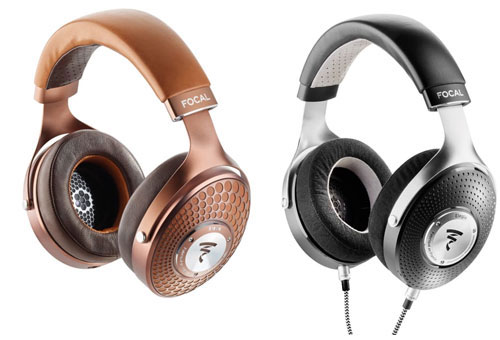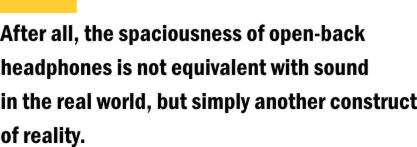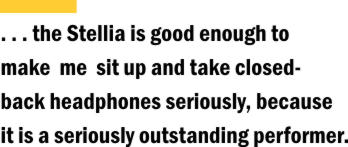Focal
• Stellia and Elegia Headphones
Closed-back headphones from one of high-end audio's premier speaker makers.
Noise reduction is obviously a very good thing for any type of audio system. We go to great lengths to reduce noise at every stage of our systems, starting with a quiet mains supply, from where the power line enters your home, all the way through to the choice of properly designed power cords. Listening rooms are designed to isolate from the outside world in order to reduce (as much as your budget will allow) the 30 to 40dB noise floor of a normal “quiet” environment. Thus, the headphone trick of adding a hard shell of insulated plastic over your ears seems like an obvious solution to a noise problem that could easily cost six figures to achieve with a speaker-based system in a dedicated sound room.
Several years ago, Focal entered the headphone market with portable models, and then jumped into the pool at the deep end with its $4000 Utopia and $1000 Elear, both of which I reviewed in 2018. It then filled in the lineup with the Clear, priced at $1500. These open-back designs instantly became leading contenders at each price point. Now Focal is challenging the perception of closed-back headphones as the ugly stepchildren of personal audio with two new models -- the $900 Elegia and the $3000 Stellia. Despite the price difference, a first glance exposes many similarities between the two models. Each comes in an almost identical hard-shell carrying case. The Stellia's carrying case is covered in a brown/black fabric to match the headphones’ cognac/mocha color scheme, and the Elegia's case is covered in a gray/black fabric to match its black-and-silver color scheme. The shape and design of the two headphones are identical except in the details. Unlike most closed-back headphones, the two new Focal models are designed to look like their open-back siblings. Rather than turtle-like exterior shells over the ear cups, Focal has designed the enclosures to mirror the open look of their other headphones. The Stellia, especially, could pass at first glance as an open-back design. The shell looks much like a microphone, with a polished cut-out placed over a lighter matte surface to give the impression of an open grille. The less intricate ear-cup design of the Elegia substitutes a pattern of pits in the surface in order to give the appearance of an open grille. But don’t be fooled by the open-looking carriage -- these are true closed-back designs that create an effective barrier between your ears and the outside world. Important differences between the Stellia and Elegia are the drivers and the details of the casing. The Stellia uses a 40mm full-range M-shaped Beryllium driver similar to that used in the top-of-the-line Utopia, while the Elegia has a 40mm aluminum/magnesium M-shaped dome driver like that used in the Clear and Elear models. The creature comforts of the Stellia largely match the plush richness of the more expensive Utopia. The ear cushions, made of “memory foam cushion” covered in the softest glove leather, are heavenly to touch and wear, and the leather headband is very comfortable on the head. The Stellia uses an aluminum yoke, rather than the carbon-fiber yoke of the Utopia. The Elegia substitutes microfiber fabric for leather on the ear cups and on the headband. It also employs an aluminum yoke that looks identical, except for color, to the one for the Stellia, although on my head the yoke of the Stellia felt a bit more forgiving than that of the Elegia. I still find the Utopia the most comfortable headphones on the market, bar none. The Stellia has a very similar feel, lacking only the lighter touch of the Utopia’s carbon-fiber yoke. The Elegia lacks some of these high-end frills, but still is as comfortable, or more so, than any 'phones in their price category. Although your mileage may vary due to your unique head shape, I find that comfort levels must be evaluated over long- and short-term listening. The Focal headphones have a bit of a clamping effect that seems a little more confining than with other headphones. But the real test is what the headphones feel like an hour into listening. In a short listening session, I sometimes prefer the feel of other headphones like my Audeze LCD-3s, which sit on my head more like a pillow than a vice. But over the long haul, the more secure feel of the Focal models wins hands down. Another difference between the two Focal models, and it’s a big one, is the choice of cables. The Elegia comes with a single 1.2-meter cable with a 3.5mm stereo plug (for plugging into portable gear), plus an adapter to for a 6.35mm stereo jack (for plugging into your desktop gear). Focal lists the Elegia under both its "Home" and "Mobility" categories, but the short cable length is simply not practical for home use. My headphone amplifier rests on an equipment rack a couple feet off the ground, and the 1.2-meter cable would require me to sit on the floor next to the equipment rack. The Stellia comes with both a four-foot unbalanced and a ten-foot balanced cable. Rather than using an extension cable (none supplied), I listened to the Elegia with the ten-foot Stellia cable, except when paring the Elegia with a mobile device. Cables for both models are interchangeable because their end connections are via 1/8” stereo jacks. started my listening with a very good piano recording, the CD of András Schiff playing Robert Schumann’s Geistervariationen [ECM 2122/23], a 2010 recording in the Reitstadel concert hall in Oberpfalz, Germany. The title piece is Schumann grappling with his debt to Beethoven, played by a pianist sometimes referred to as having a “mighty” left hand. The companion pieces include several earlier Schumann works that favor the delicacy of the right hand along with the composer's inherent lyricism. But first a general word about headphone bass. Where earlier bass-hungry generations of audiophiles tuned their playback systems with overcooked subwoofers, today’s “Beats” generation sometimes strives for that same result with bass-heavy headphones. The tendency is so well understood that certain wags on the Internet forums have sorted the misdemeanors into three classifications of abuse, with the well-known bass-abusing Beats headphones falling only into the middle classification. Where do the new Focal headphones fit into this scheme? When Schiff’s left hand comes down in the lower registers, the Stellia's bass is fast, clean and dynamic, with no overhang or bloat. While your choice of amplifier may affect the ability of the Stellia to deliver its best dynamics and speed, deep, clean and fast bass is almost a trademark of the Focal line whether open- or closed-back. The much less expensive Elegia comes very close to matching the Stellia as far as bass response goes, and despite my ultimate preference for an open-back design, when it comes to dynamic bass response, the advantages of open-back design are less persuasive at the low end. Listen to a more modern recording with prodigious amounts of electronic bass, like T.J. and the Revenge on Little Lost Records (no catalog number) and you can appreciate how deep and clean the bass response can be. There is nothing overcooked or bloated about the bass response of either the Elegia or Stellia, both of which deliver fast, tight bass with realistic weight. The real test of a closed-back design, however, resides in the upper frequencies. Who wouldn’t want music reproduction to sound more open, less closed in? Back to András Schiff. The Stellia does an admirable job of capturing the delicacy of his right hand, and with a smaller-scale performance such as this, it was almost possible to forget that I was listening to closed-back headphones, the delicate notes floating outside my head. This was not quite the equal of the best open-back designs like the Utopia, but good enough to trick you -- until you switch models, that is. This sleight of hand becomes harder when you switch to orchestral music, where the musicians in play are spread out over a large space. Václav Neumann’s performance of Dvorák’s Ninth Symphony [Denon COCO-73088] throws a huge soundstage when played through speakers. I can look out over my listening room and imagine that it’s the size of a symphony hall, with the percussion and first violin sections far removed from each other. With the better open-back designs from Focal, Audeze or several other makers, the image floats far enough outside my head to make me forget that I've reduced my listening space -- from a hall to the beehive space around my head. This kind of music has always been the stumbling block for closed-back designs, collapsing that beehive to a scaled-down image no wider than your eye sockets. The best mass-produced designs, familiar to a wide audience for air travel, don’t even come close to expanding this space limitation. The Sony WH-1000XM3, one of today’s most popular travel headphones (it includes active noise cancellation) is most non-audiophiles' idea of a high-end headset, and at $350, it packs a lot performance into a very small, portable and lightweight package. But it highlights the limitations of closed-back headphones. A quick comparison of the Sony with Focal’s “budget” closed-back model highlights that the Elegias are serious headphones for music lovers who demand fine reproduction. The Sonys’ relatively thin and lightweight sound is exposed, making it easy to affirmatively answer the typical non-audiophile question -- “But is it really three times as good?” The tradeoffs in added weight and size bring a dramatic increase in musical authenticity -- depth of musical texture and dimension that make the listening experience more than shutting out the outside world. The Elegia packs up in its handsome carrying case, and the short cable is perfect for portable listening. I plugged it into an AudioQuest DragonFly DAC and iPhone full of music copied from CDs. Alisa Wailerstein playing Shostakovich’s Cello Concerto with the Symphonieorchester des Bayerischen Rundfunks [Decca 483 0835] transported me back to hearing her perform the piece live in the Concertgebouw a few years ago. Bass, high-frequency extension, gorgeous tonal accuracy and explosive dynamics were all in abundance, needing only about half of the iPhone’s volume range. The Elegia’s 105dB sensitivity makes it easy to run with an iPhone (the Stellia, at 106dB, is just as sensitive). The hard-shell case is the size of a small man-purse and is covered in the same fabric as my preferred carry-on luggage, a small backpack from Peak Design. There's one final bit of context to add: how the Focal 'phones compare to high-quality in-ear monitors like my Ultimate Ears UE 18 Pro ($1500). I used to think that these IEMs were about as good as it got in personal audio transducers. However, the Elegias present much more detail and upper-frequency extension, more space around the instruments, and, for some reason, less exaggerated tape hiss with my iPhone CD copies, like Respighi’s Ancient Airs and Dances/Suites Nos.1-3 [Mercury 434 304-2]. The Elegia was only found wanting when compared to the Stellia, especially when listening through a full-sized home front-end. For example, play the Wailerstein performance direct from CD into a high-end headphone amplifier and then into the Stellia and suddenly everything changes. The cello sounds more robust and the entire orchestra expands like a watered Chia Pet. Oh, right! That’s what an orchestra is supposed to sound like. The Elegia in some ways clears the table of other headphones competing for top honors in the mobile category, while making a very respectable showing as an excellent home headset. The Stellia, on the other hand, competes with top open-back headphones. Take the aforementioned Respighi piece, played back using physical media, either the CD or LP [Mercury SR 90199] and the soundstage collapses just a bit compared to excellent open-back headphones. Small-group jazz presents a closer call. With Hank Mobley’s Soul Station on XRCD24 [Audio Wave AWMXR-0001], some might find Mobley’s saxophone sound just a tad lush with open-back headphones and the distance that Wynton Kelly’s piano is placed back from the front of the stage just a mite exaggerated. The Stellia pulls the musicians into a tighter grouping that some listeners may prefer even to the sound of the best open-back designs like the Utopia. Listening to some very densely textured music like Wadada Leo Smith’s recent Rosa Parks: Pure Love CD [TUM CD 057], where the intensity of the music can be overwhelming, I preferred the slightly more enclosed feeling of the Stellia’s presentation.
|
|||||||||||




 The problem
is that the aural downside of closed-back headphones has long been thought to outweigh the
isolation benefits. The ear cups for open-back headphones have a metal or plastic grille
with slats or holes that allow air and noise to pass freely into and out of the
headphones, giving the listener a sense of spaciousness that is very hard to match with a
closed-back design. Thus, unless you listen to headphones where you need to avoid
disturbing others around you, or need to shut out high ambient noise from others, or you
are a studio engineer monitoring recordings for which detail is more important than
spaciousness, the first choice for high-end headphones has always been open-back designs.
That’s not to suggest there are those headphone enthusiasts who don’t prefer the
closer, “in your head” sound of closed-back headphones. After all, the
spaciousness of open-back headphones is not equivalent with sound in the real world, but
simply another construct of reality. Whether the soundstage floats several feet around
your head or is more contained does not get you any closer to real-world staging. It's
simply a different perspective. However, until fairly recently, the perception that
closed-back headphones are not for serious listening was such accepted wisdom that few
manufacturers marketed high-performance closed-back models.
The problem
is that the aural downside of closed-back headphones has long been thought to outweigh the
isolation benefits. The ear cups for open-back headphones have a metal or plastic grille
with slats or holes that allow air and noise to pass freely into and out of the
headphones, giving the listener a sense of spaciousness that is very hard to match with a
closed-back design. Thus, unless you listen to headphones where you need to avoid
disturbing others around you, or need to shut out high ambient noise from others, or you
are a studio engineer monitoring recordings for which detail is more important than
spaciousness, the first choice for high-end headphones has always been open-back designs.
That’s not to suggest there are those headphone enthusiasts who don’t prefer the
closer, “in your head” sound of closed-back headphones. After all, the
spaciousness of open-back headphones is not equivalent with sound in the real world, but
simply another construct of reality. Whether the soundstage floats several feet around
your head or is more contained does not get you any closer to real-world staging. It's
simply a different perspective. However, until fairly recently, the perception that
closed-back headphones are not for serious listening was such accepted wisdom that few
manufacturers marketed high-performance closed-back models. t the end of
the day, how good are these two new closed-back headphones? While neither is a Utopia
beater, no other dynamic headphones in my experience quite makes that grade either. For
sheer comfort, the Utopia’s carbon-fiber yoke still provides a plush ride that edges
out the Stellia. But the Stellia is good enough to make me sit up and take closed-back
headphones seriously, because it is a seriously outstanding performer. Indeed, if you
value bass impact and dynamics over the sense of air and space provided by open-back
headphones, you may prefer the Stellia. If you are crazy enough to carry around a $3000
set of cans as your mobile headphones, look no further than the Stellia. I can’t
think of a better-sounding set of headphones that pack up light and portable, yet do
double duty as stay-at-home gear. If, on the other hand, the Stellia is beyond your budget
or you are too risk-averse to expose something this dear to light-fingered audiophiles,
the Elegia comes close at a fraction of the price.
t the end of
the day, how good are these two new closed-back headphones? While neither is a Utopia
beater, no other dynamic headphones in my experience quite makes that grade either. For
sheer comfort, the Utopia’s carbon-fiber yoke still provides a plush ride that edges
out the Stellia. But the Stellia is good enough to make me sit up and take closed-back
headphones seriously, because it is a seriously outstanding performer. Indeed, if you
value bass impact and dynamics over the sense of air and space provided by open-back
headphones, you may prefer the Stellia. If you are crazy enough to carry around a $3000
set of cans as your mobile headphones, look no further than the Stellia. I can’t
think of a better-sounding set of headphones that pack up light and portable, yet do
double duty as stay-at-home gear. If, on the other hand, the Stellia is beyond your budget
or you are too risk-averse to expose something this dear to light-fingered audiophiles,
the Elegia comes close at a fraction of the price.